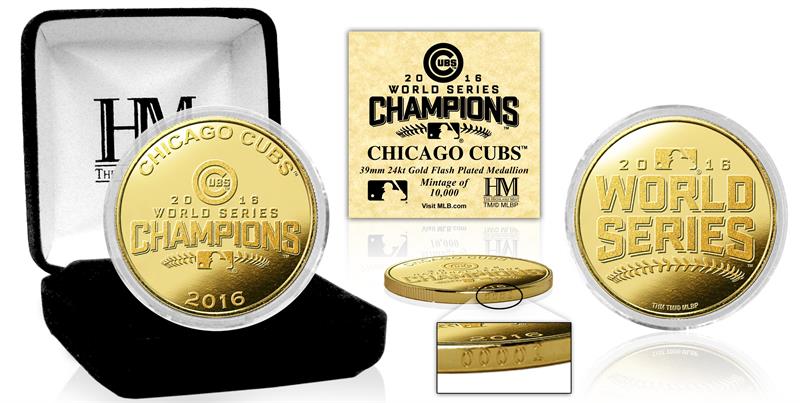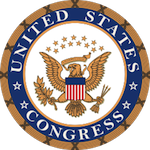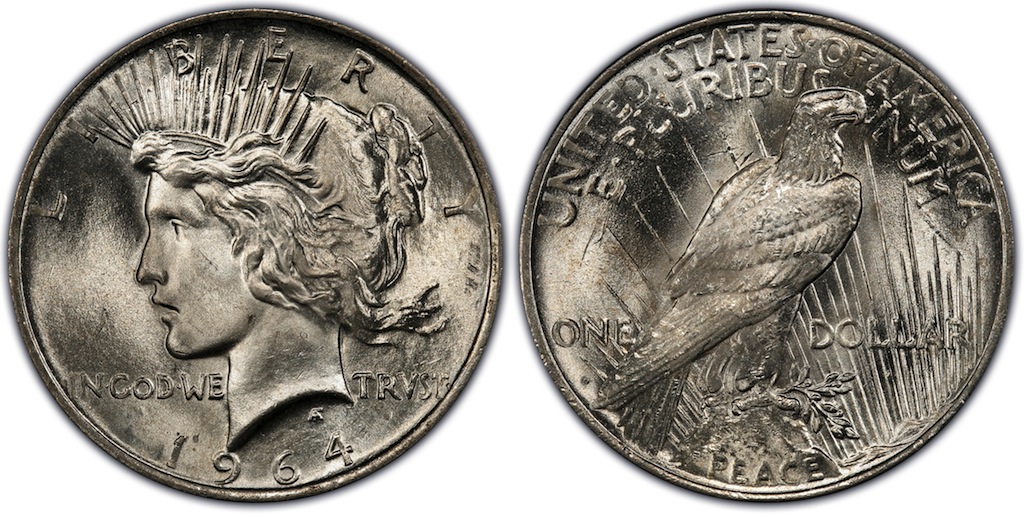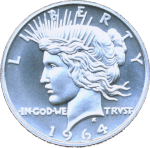HOLY COW!
Obligitory numismatic content:

Cubs numismatic collectibles can be purchase from the Highland Mint or MLBShop.com
- Medal image courtesy of the Highland Mint.
- Cubs W Banner courtesy of the Chicago Cubs and Major League Baseball.

Cubs numismatic collectibles can be purchase from the Highland Mint or MLBShop.com
In a comment about a technical issue, I was trying to explain that something would not work and exclaimed, “That isn’t worth two-bits.”
To the few people in the room within my age group, they understood what I said. Those younger than being eligible for AARP and those born outside of the United States did not understand. Since it is more blessed to give rather than receive, it gave me the opportunity to teach someone about the origin of money in the United States.
When the colonies were settled, George I was the King of England. Although the king ruled from an ocean away, the governors sent to manage the colonies on his behalf were under strict orders to not allow the colonists to coin money. An exception was made during a small period in the 17th century, colonists had to make due with the low-value copper coinage the king and his governors allowed.
Even with a standing army in the colonies, the governors could not control the commerce. Instead, they applied duties and fees for allowing the colonists to trade with the rest of the Western Hemisphere. Notice that there were no taxes because only the king could tax the royal subjects. Governors could levy duties to run the colonies. They also took kickbacks and bribes in order to get their way.
Although the Pound Sterling was the coin of the realm it was not available to the colonies. Instead, trading posts accepted the 8 reales coin, also known as the Thaler or Spanish Milled Dollar, as payment for goods and services. With the trade of high-cost goods like tobacco, cotton, and hides caught in the Appalachian Mountains the colonies relied more on the Spanish Milled Dollar than on the copper British coins.
Colonial governors ignored the growing economy, as they were able to satisfy the companies that sponsored the settlements and paid the taxes while lining their pockets. Colonists were able to make do with what was left.
A problem came about that everything could not be worth 8 reales and without subsidiary coinage, it was impossible to give change. Using the silver value of the coin, people would cut the coin into pieces in order to make subsidiary coinage. A milled dollar cut in half was a half-dollar. That half-dollar cut in half was a quarter-dollar and the quarter-dollar cut in half was called a bit.
The bit was the basic unit of commerce since prices were based on the bit. Of course, this was not a perfect solution. It was difficult to cut the quarter-dollars in half with great consistency which created problems when the bit was too small, called a short bit. Sometimes, goods or services would be adjusted to accommodate the short bit. Other times, short bits were supplemented with the English pennies that were allowed to circulate in the colonies.
Getting back to our adage, two bits were made from a quarter-dollar. Saying something was not worth two bits was either a negotiating tactic or someone wanted to use a short bit to pay for an item. Like many adages that have origins in the 17th and 18th centuries, the reason for their existence has been lost with time.
But arguing about its origin would be rocking the boat. We do know that some of our colonial ancestors should have measured twice and cut once to avoid the problem. But alas, there is no sense crying over spilled milk.
Although this is not numismatic-related, I thought my readers would like a different type of collectible diversion.
 Today I will be attending the taping of Antiques Roadshow in Virginia Beach, Virginia. As a fan of the show, I am fascinated by the vintage and antique items people find, the stories behind them, and what they end up being worth. Of course they pick out the best stories and phenomenal values to feature on the broadcast, but one can only hope.
Today I will be attending the taping of Antiques Roadshow in Virginia Beach, Virginia. As a fan of the show, I am fascinated by the vintage and antique items people find, the stories behind them, and what they end up being worth. Of course they pick out the best stories and phenomenal values to feature on the broadcast, but one can only hope.
Although Antiques Roadshow does not appraise coins and currency, they would appraise medals, military awards, and even old stock certificates that were signed by famous business leaders. Unfortunately, I do not have any of those items to appraise. Since we are only allowed to bring two items to appraise, I am bringing the following:
The poster from Grand Valley State College (now Grand Valley State University) is from a pair of 1972 shows by humorists Dick Gregory and Mort Sahl. It was hung on campus and not made to last. I have not seen another like and and the only listing of it online is in the university’s library. This was picked at an estate sale for $10.00.
The music box is Swiss made and there is a faint hallmark that can be seen on the mechanism that suggests it was made around 1922. The motor works well and all of the teeth are attached and play loudly. The interesting thing about this music box is that it plays six 30-second arias. When it reaches the end of an aria, the mechanical mechanism will move the drum over to play the next one. After the sixth aria it will move the drum back to the first position. This was an auction buy which I forgot what I paid.
If you want to following along, you can follow the various social media outlets for my business Having-Fun Collectibles—after all, it is not numismatics.
It is common for people to use the hashtag #antiquesroadshow on all of these sites. I hope to remember to use this tag.
Have a good weekend!
No, the U.S. Mint is not being privatized or sold to anyone. Given the significance of the date, I thought I would add to the fun.
If you read the post carefully, you would have noticed:
In short:

Like the Orson Well’s broadcast of The War of the Worlds, all you had to do is change the channel (or check another source).
That was fun!
Stand by for more on the Whitman Baltimore Spring Expo.
 In what is seen as an election year move during a late night session, congress voted mostly along party lines to sell the U.S. Mint and its assets to a private corporation headed by the founders of the Poboy Mint.
In what is seen as an election year move during a late night session, congress voted mostly along party lines to sell the U.S. Mint and its assets to a private corporation headed by the founders of the Poboy Mint.
The measure moved quickly through congress after the bill was introduced by House Banking Committee Chairman Jed Harding. In his floor statement, Harding said that he and his senate counterpart Carroll Cobra have been discussing this with interested companies and other members for more than a year. They see it as a way to make money without making money.
Under the terms of the agreement, the current U.S. Mint properties will be leased to the Mint of the United States Corporation (MUSC), the new entity being created for this venture. They are required to use these facilities for 50 years at which time either party can end the agreement with 120-days notice.
Rep. Brad Hoyle said that he worked hard to ensure that the facility in Philadelphia remained. “The Mint employs a lot of people in Philadelphia,” Hoyle said. “We just couldn’t see all those jobs leaving.”
“Besides,” Hoyle continued, “how would it look if the city where the Mint started would lose the Mint after all these years? It would be devastating to our local economy.”
Dana Gillette, who represents Denver was note as upbeat. Gillette disagrees with the privatization efforts saying, “I know the constitution does not say that the government doesn’t have to own the Mint, but this is a bit too far.”
The transfer to MUSC will begin immediately, ending 224 years of operating as a government entity.
At the 2016 New York Toy Fair, Hasbro announced that it will release an “update” the famedMonopoly game creating the Monopoly Ultimate Banking Game where the cash has been eliminated for electronic bank cards. The bank is now a hand-held unit that will scan the bank cards to make transactions.
As part of the game, the bank card is used to pay rent, taxes from the cards, and buy property. The new property cards will now have bar codes for the players to scan in order to make the purchase or mortgage their property.
This version of Monopoly will still have Chance cards. Previews suggest that the Community Chest cards have been eliminated. Chance cards will now allow for market crashes, fluctuations in rent, and other “real life” scenarios faced in the modern age.
Hasbro does have an Electronic Banking edition that uses a similar hand-held device. A Hasbro representative said that the Electronic Banking edition is the traditional Monopoly game using the bank card technology. It does not have the ability to scan property cards for transactions and requires more manual input than will be allowed for the Ultimate Banking Game.
Recently, the advocates for a cashless society or one that uses a limited amount of physical currency have been on their virtual soapboxes trying to find every reason to eliminate cash. One story that appeared on the CNBC website reported about a San Francisco-area restauranteur who tried to accept only credit cards had to reverse the decision because of backlash from customers.
There are segments of our culture who do not trust banks. There are industries that work better when the transactions are made in cash. There are some of us who do not like the electronic trail non-cash transactions create. These are only some of the reason cash will continue to live on.
Hasbro said that the Monopoly Ultimate Banking Game will be released later this summer. My only question is will it support house rules like double payment for landing on Go or having the taxes paid to the Free Parking pool for the next player that lands there?
We need to build a wall!
We know that the Royal Canadian Mint struck their last 1-cent coin in 2012. During the six-month transition, Canadian banks were helping recall 1-cent coins while cash sales began to be rounded up or down to the nearest 5-cents.
But when I made a purchase at a local convenience store, my change included a 1966 Canadian 1-cent coin. Even though the coin is still legal tender it is not usable. I can visit an agent for the Bank of Canada or the Royal Canadian Mint to turn it in for updated coins. I was told that the minimum they will take for exchange is 100 coins. If I can scrape together 99 more coins I can trade it for a Loonie.
At the current exchange rate, the coin is worth only 0.0074 U.S. cents. Someone owes me 0.0026 cents!
Maybe I should go back to that store and see if they would give me a Canadian 5-cents coin and I would give them four U.S. cents. That would make it even.
It’s Friday. Why not have a little fun after finding a Canadian cent in my change!
 As I write this the current estimated jackpot for Powerball on Wednesday, January 13, 2016 is $1.4 billion. It is the largest lottery jackpot in history.
As I write this the current estimated jackpot for Powerball on Wednesday, January 13, 2016 is $1.4 billion. It is the largest lottery jackpot in history.
If you win the jackpot and elect to be paid out over 30 years, you will receive $46,666,666.66 per year, less taxes.
The cash-out option, where you take all of the cash up front, is estimated to be “only” $868 million, less taxes.
As for the taxes, the lottery takes 25-percent off the top but you will still be required to pay the federal rate of 39.6-percent and your state tax. In places like New York City there is also a city tax. While I love New York, I would move before collecting the prize!
If you were wondering, the best place to move because of the taxes would be to California. California does not tax lottery winnings. But you will be subject to the federal income taxes at the highest rates.
For discussion, let’s imagine that you won and decided on the cash-out option. If you consider your state tax is the average of 7-percent, you will be left with $747.6 million. After you pay the bills, buy the new dream home, cars, vacations, etc., most of my readers should consider what you are going to do with your numismatic collection. You can build a great collection or purchase just about any coin with what is left.
What is your numismatic fantasy?
If I win Powerball, I will put up a $15 million reward for the owner of a surviving 1964-D Peace dollar to sell this special coin to me. The coin must be able to be certified as legitimate by experts in a manner that the Walton Liberty Head Nickel was certified. The reward will be paid only if the coin can be certified.
Why did I choose $15 million? Because I wanted to ensure that it was the most expensive coin on record. For a coin this special and this unique, it should be an appropriate price.
You know mine, what is yours?

PCGS is offering a $10,000 reward to verify a genuine 1964-D Peace dollar, the number one coin on the new PCGS Top 100 Modern U.S. Coins list. This image is a PCGS artist’s conception of a 1964-D Peace dollar.
 Sometime in 2005 I began to search the Internet for information about coins. The two major publications, Coin World and Numismatic News, were not quite fully engaged online at that time. There were other online services but there was not something that would be the voice of a collector. Chat boards are nice but they are fractured. I wanted to have a conversation with the community.
Sometime in 2005 I began to search the Internet for information about coins. The two major publications, Coin World and Numismatic News, were not quite fully engaged online at that time. There were other online services but there was not something that would be the voice of a collector. Chat boards are nice but they are fractured. I wanted to have a conversation with the community.
Although I have a technical background, I did not know how to create and run a blog. After doing some research I discovered Blogger, Google’s blogging platform. After playing with the administration and learning how to create a blog post, I wrote my first post on October 29, 2005.
In my first post, I said that the coins I like include “Adolph A. Weinman’s Walking Liberty Half-Dollar and Liberty Head “Mercury” Dime, James Earl Fraser’s Buffalo Nickel, Augustus Saint-Gaudens’ $20 Double Eagle, and Bela Lyon Pratt $5 Half-Eagle.” Not much has changed except for my interest in exonumia, especially those pieces with ties to New York City, and the addition of Canadian coins to my collection
The blog has changed, or I would like to think it has evolved over the years. The biggest change was moving away from Blogger to my own domain. As part of the move I decided to create a logo using the allegedly non-existent 1964-D Peace Dollar, and I now participate social media specifically Twitter and Pinterest. What has not changed is the amazed and humbling experience I feel when I look at the server logs to see that more than 1,000 people read my posts—even with the recent slowdown in writing.
Stay tune… more to come!
 The other day I walked into the office of a big-shot producer and pitched a story for a movie that had the possibilities of a sequel. Here is the story I pitched:
The other day I walked into the office of a big-shot producer and pitched a story for a movie that had the possibilities of a sequel. Here is the story I pitched:
Flash to Washington where President Franklin D. Roosevelt signs Executive Order 6102 that banned the private use of gold for currency.
Transition back to Philadelphia where a shadowy figure, presumably the U.S. Mint’s cashier, is locking the doors of the coin room but is clearly clanking coins in his pocket.
Watch as the cashier grabs his coat, hat, a small bag and leaves the Mint. He walks to the Philadelphia’s diamond district where he knocks on the backdoor of jeweler Israel Switt. Switt opens the door and the two men talk. Switt hands the cashier a bag and the cashier hands the bag he was carrying to Switt then leaves.
Fast forward to 1944. An emissary for King Farouk of Egypt is meeting with someone at the State Department to obtain permission to export a 1933 double eagle to Egypt for his vast collection. Not knowing whom to call, the State Department worker calls the Smithsonian who verifies the coin that leads to an export permit.
Next, a series of investigations and stories about the seizing of 10 double eagle coins that the Secret Service says should not have left the U.S. Mint. This part of the story goes to 1952.
Scene is the famous Waldorf-Astoria Hotel in New York in 1996. British coin dealer Stephen Fenton is attempting to buy a 1933 double eagle when the Secret Service interrupts the transaction and arrests him.
Attorney Barry Berke helps get Fenton out of jail and begins to build a case against the government. The defense claims that King Farouk of Egypt legally exported the coin. Some court drama and negotiations lead to charges against Fenton being dropped but the coin not returned to Fenton.
The scene is Federal Court in Manhattan where Berke is negotiating a settlement with federal attorneys. Finally, in July 2001, both sides agree that the coin would become federal property and sold at auction. The Fenton and the government would split the proceeds of the auction. The government required the buyer pay an extra $20 to officially monetize the coin.
Flash to the World Trade Center where the coin is removed from a safe and transferred to the government.
Brief pause for a scene about the destruction of the World Trade Center.
Fade to Southeby’s Auction on July 30, 2002 where the coin sells for $6.6 million plus a 15-percent buyer’s premium. After the auction Stephen Fenton received $3.3 million. Another $3.3 million was deposited in the federal treasury. Southeby’s and their auction partner Stack’s earned $990,000. The president of Southeby’s will pull $20 out of his pocket and hand it to the government’s representative to monetize the coin.
New scene is in a dark basement in Philadelphia. Joan Langbord, Israel Switt’s surviving daughter, will be opening boxes as if she was looking for something. Soon she would find a bag with ten 1933 Saint-Gaudens double eagle coins.
Langbord contacts the U.S. Mint and hands the coins over for authentication. In July 2005 they determine the coins are real and confiscates them.
Langboad contacts Berke to help recover the coins.
First trial occurs in July 2011, which leads to a unanimous decision against Langbord who was joined by her sons in the lawsuit. The elderly Langbord did this to protect the family’s interest.
Scene changes to the transfer of the ten coins to the Bullion Depository at Fort Knox, Kentucky.
Langbord appeals and a three-judge panel will vacate the forfeiture and order the government to return the coins.
The government appeals and asks that the return order be vacated in order to appeal the decision. Rather, the Chief Judge of the Third Circuit will stay the order and ruled that the appeal will be en banc, meaning that the appeal will be heard before the entire bench of judges this year.
Fade to the image of the ten coins in Fort Knox with the lettering “To be continued…” overlaying the screen.
The producer found the story so unbelievable that he threw me out of his office.
Just goes to prove that reality is weirder than fiction!